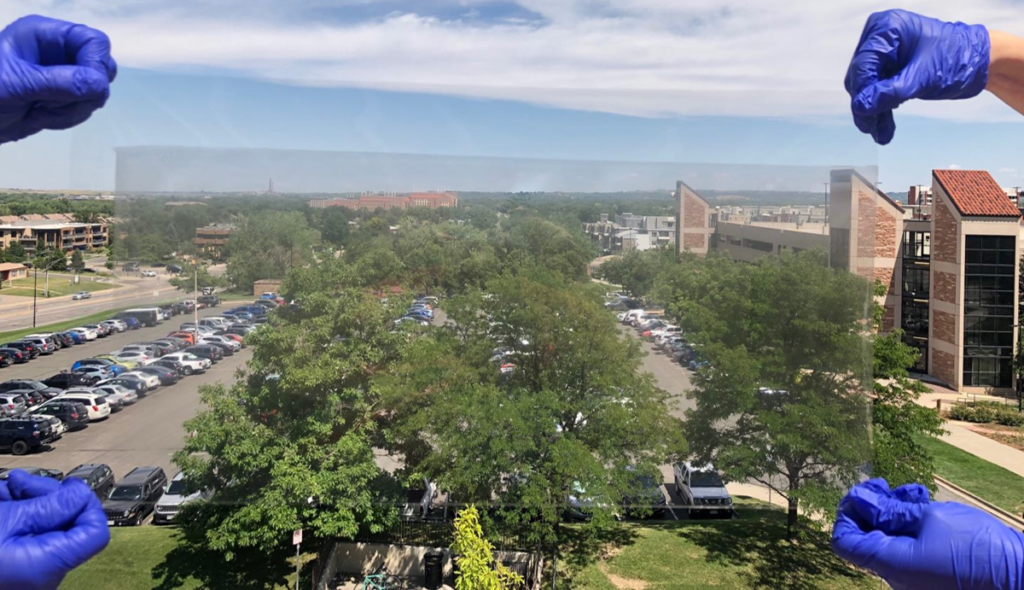Thermochromic Materials
Durability Enhanced Vanadium Dioxide Thermochromic Film
Design, fabrication and energy analysis of VO2-based thermochromic film for energy-efficient smart windows.
Year:
2020
Affiliation:
- University of Wyoming
- University of Boulder Colorado
- Norwegian University of Science and Technology
- SINTEF Building and Infrastructure
- China Hauzhong University of Science and Technology


Snapshot of a PMMA-VO2 film with a size of 600 mm × 300 mm (length × width) manufactured using the blade coating method, in which a ~ 4.0 μm thick PMMA-VO2 film is coated on a 50 μm thick transparent and chemically stable biaxially-oriented polyethylene terephthalate (BoPET) film.
With a high solar transmittance > 90%, as much as ~ 800 W/m2 solar irradiation reaches the indoor environment through windows during daytime. The transmitted solar energy significantly reduces the heating demands in cold climates. However, excessive solar irradiance also result in increased cooling demands in hot climates. Smart windows that could dynamically adjust the transmittance of solar irradiation have been subject of intense study of as one of the most promising strategy to reduce the energy consumption of buildings. In particular, Vanadium dioxide (VO2) based thermochromic smart windows can regulate solar heat gain dynamically by adapting to the change of ambient temperature. This is due to the reversible metal-insulator transition (MIT) of VO2 at critical phase transition temperature. For pure crystalline VO2, the critical phase transition temperature is ~ 68 °C but can be modified to a lower temperature for a comfortable building environment
using doping elements. i.e., tungsten and magnesium. The performance of thermochromic smart windows is evaluated by two crucial optical performance parameters: 1) luminous (visible) transmittance (τum, for wavelengths ranging between 380-780 nm), which represents the transmission of visible light useful for human vision under normal conditions, and 2) solar modulation ability (Δτsol, the difference of solar radiation transmittance τsol before and after the phase transition for wavelengths ranging between 300-2500 nm), which represents the modulation of solar radiation energy passing through the window. Currently available thermochromic films possess relatively low τlum and Δτsol. In addition, the thermochromic performance of VO2 decrease significantly when exposed to air for several months, a humid environment would also greatly accelerate the oxidation process and turn thermodynamically unstable VO2 into stable V2O5 with no solar modulation ability and thus deterring the practical deployment of VO2 based smart windows. To address this issue, durability-enhanced VO2 nanoparticle-polymer thermochromic film, was proposed and fabricated; where the cross-linked and highly entangled poly (methyl methacrylate) (PMMA) chain with molecular weight (~ 950,000) was adopted to block gas diffusion and vapor penetration into the polymer matrix embedded with ~ 3% volume fraction of VO2 nanoparticles (50 ~ 80 nm). The PMMA-VO2 film was then coated ~ 50 μm thick transparent and chemically stable biaxially-oriented polyethylene terephthalate (BoPET) sheet using blade coating. The developed film presented a relatively high luminous transmittance of ~ 50%, solar modulation ability of ~17.1%, and a low haze value of ~ 11%. Accelerated environmental tests were performed at 60 ºC temperature, and the relative humidity > 95%. The lifetime of the VO2 nanoparticles embedded in the cross-linked PMMA matrix with molecular weight ~ 950,000 developed in our work is ~ 900 hours, which is particularly better than the previously reported values for VO2 nanoparticles coated by SiO2 (~ 72 hours, Al(OH)3 (~ 120 hours), and VO2 thin film protected by Al2O3 (~ 100 hours), and is comparable to the performances of VO2 nanoparticles coated by Al2O3 (> 480 hours) and VO2 thin film protected by SiNx (~ 600 hours). Our method provides an easy and yet effective strategy to improve the lifetime of VO2 nanoparticles, suggesting a promising pathway toward environmentally stable and large-scale deployment of thermochromic films for energy-efficient smart windows. The detailed energy performance analysis shows that the developed PMMA-VO2 film could greatly reduce the cooling demands in hot climates and improve the thermal comfort in cold climates.